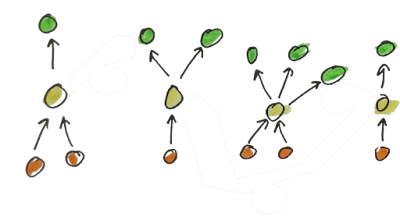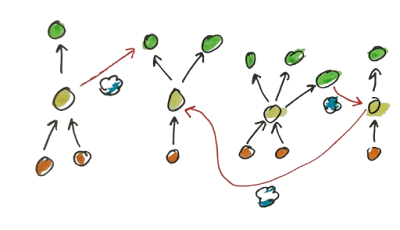Antes de aparecer a ideia de mapa da estratégia, apareceu a ideia da "service profit chain". No livro, de 1997, logo nas páginas 11 e 12 pode ler-se:
"Simply stated, service profit chain thinking maintains that there are direct and strong relationships between profit; growth; customer loyalty; customer satisfaction; the value of goods and services delivered to customers; and employee capability, satisfaction, loyalty, and productivity. These relationships are shown in Figure 1-2. Notice that market share is not mentioned in these relationships. In few industries studied by Sasser and Reichheld was market share a more important predictor of profitability than customer loyalty.
The strongest relationships suggested by the data collected in early tests of the service profit chain were those between: (1) profit and customer loyalty, (2) employee loyalty and customer loyalty, and (3) employee satisfaction and customer satisfaction. They suggested that in service settings, the relationships were self-reinforcing. That is, satisfied customers contributed to employee satisfaction, and vice versa."
Entretanto, no WSJ do passado dia 18 de Outubro li "Walmart Becomes a Case Study":
"He crafted a plan to raise wages. He brought in a new crop of Walmart leaders, including new U.S. chief executive and chief operating officers. Their proposal would reduce employee turnover, which would improve operations in the stores and warehouses.
They could invest in more training to get workers to stick around with promotions. Stores would be more organized. Sales would increase, and Walmart would be better positioned for e-commerce, the argument went. The board approved and said they needed to move faster than proposed to boost pay.
...
That fall [Moi ici: Em 2015], at an investor meeting at the New York Stock Exchange, then-Chief Financial Officer Charles Holley clicked through his slide presentation for analysts and quantified the change. It would be a $2.7 billion cost over two years, plus more later to lower prices, improve stores and grow online. Earnings per share would drop by 6% to 12% the following year due to the investments. As the slides lingered on the screen, Walmart shares began to tumble.
...
Walmart shares have more than doubled over the past five years. Its U.S. sales have grown each year since 2015 and global sales hit $681 billion last year, helping it maintain its spot as the country's largest retailer by revenue."
A estratégia, inicialmente vista como arriscada por investidores, transformou-se num movimento que aumentou a retenção de trabalhadores, melhorou a experiência do cliente e fortaleceu a posição competitiva da empresa, inclusive face à Amazon. Além de salários, a Walmart expandiu benefícios como licenças, formação e educação. A empresa também investiu em redes de academias regionais para preparar colaboradores para promoções, reduzindo turnover e reforçando a cultura interna. Hoje, a Walmart colhe resultados positivos em vendas e valorização das acções, sendo vista como um exemplo de como alinhar investimento nos trabalhadores com sucesso empresarial.
O livro "The Service Profit Chain" defende que existe uma cadeia de causa-efeito que liga:
- Investimento em colaboradores (salários justos, formação, ambiente de trabalho, benefícios) →
- Maior satisfação e lealdade dos colaboradores →
- Melhor serviço entregue ao cliente →
- Maior satisfação e lealdade dos clientes →
- Maior crescimento e rentabilidade da empresa.
- O artigo mostra que a Walmart aumentou salários e expandiu benefícios (licenças, formação, educação gratuita).
- "Walmart has increased its hourly staff-retention rate by 10% since 2015, the company said."
- Isto corresponde ao primeiro elo da cadeia: criar valor para os colaboradores.
- "They could invest in more training to get workers to stick around with promotions."
- Com maior estabilidade, os trabalhadores ficaram mais leais, menos turnover.
- Isto reforça o elo da satisfação e lealdade do colaborador.
- "Stores would be more organized. Sales would increase, and Walmart would be better positioned for e-commerce growth."
- O impacte directo é visível: trabalhadores mais motivados → lojas mais organizadas → melhor experiência de compra.
- "The company's stock is up more than four times from when it raised wages in 2015..."
- Aqui vemos o fim da cadeia: maior lealdade e satisfação dos clientes traduzem-se em crescimento e valorização do negócio.


%2016.21.jpeg)
%2016.41.jpeg)
%2013.30.jpeg)
%2013.35.jpeg)
%2014.04.jpeg)
%2014.16.jpeg)

%2014.50.jpeg)
%2010.02.jpeg)
%2014.57.jpeg)
%2016.41.jpeg)
%2016.56.jpeg)
%2017.03.jpeg)
%2017.29.jpeg)
%2017.29%20(1).jpeg)
%2017.30.jpeg)
%2017.30%20(1).jpeg)
%2011.44.jpeg)
%2018.01.jpeg)
%2009.53.jpeg)
%2011.45.jpeg)
%2010.12.jpeg)
%2009.59.jpeg)
%2010.29.jpeg)
%2017.17.jpeg)
%2017.30%20(1).jpeg)






















%2006.21.jpeg)












